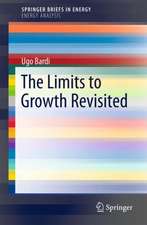Integrated Assessment of Sustainable Energy Systems in China, The China Energy Technology Program: A Framework for Decision Support in the Electric Sector of Shandong Province: Alliance for Global Sustainability Bookseries, cartea 4
Editat de B. Eliasson, Y. Leeen Limba Engleză Paperback – 30 apr 2003
Din seria Alliance for Global Sustainability Bookseries
- 20%
 Preț: 559.94 lei
Preț: 559.94 lei - 15%
 Preț: 640.06 lei
Preț: 640.06 lei - 15%
 Preț: 644.49 lei
Preț: 644.49 lei - 15%
 Preț: 650.55 lei
Preț: 650.55 lei - 18%
 Preț: 1236.38 lei
Preț: 1236.38 lei - 15%
 Preț: 637.13 lei
Preț: 637.13 lei - 15%
 Preț: 643.84 lei
Preț: 643.84 lei - 5%
 Preț: 1100.09 lei
Preț: 1100.09 lei - 18%
 Preț: 950.96 lei
Preț: 950.96 lei - 18%
 Preț: 953.20 lei
Preț: 953.20 lei -
 Preț: 385.47 lei
Preț: 385.47 lei - 18%
 Preț: 952.26 lei
Preț: 952.26 lei - 15%
 Preț: 656.58 lei
Preț: 656.58 lei -
 Preț: 377.57 lei
Preț: 377.57 lei - 15%
 Preț: 645.79 lei
Preț: 645.79 lei - 15%
 Preț: 639.90 lei
Preț: 639.90 lei - 15%
 Preț: 645.28 lei
Preț: 645.28 lei - 15%
 Preț: 644.49 lei
Preț: 644.49 lei - 27%
 Preț: 621.02 lei
Preț: 621.02 lei
Preț: 849.52 lei
Preț vechi: 1117.80 lei
-24% Nou
Puncte Express: 1274
Preț estimativ în valută:
162.56€ • 173.83$ • 135.54£
162.56€ • 173.83$ • 135.54£
Carte tipărită la comandă
Livrare economică 14-19 aprilie
Preluare comenzi: 021 569.72.76
Specificații
ISBN-13: 9781402011993
ISBN-10: 1402011997
Pagini: 880
Ilustrații: LVI, 824 p. With online files/update.
Dimensiuni: 160 x 240 x 46 mm
Greutate: 1.52 kg
Ediția:2003
Editura: SPRINGER NETHERLANDS
Colecția Springer
Seria Alliance for Global Sustainability Bookseries
Locul publicării:Dordrecht, Netherlands
ISBN-10: 1402011997
Pagini: 880
Ilustrații: LVI, 824 p. With online files/update.
Dimensiuni: 160 x 240 x 46 mm
Greutate: 1.52 kg
Ediția:2003
Editura: SPRINGER NETHERLANDS
Colecția Springer
Seria Alliance for Global Sustainability Bookseries
Locul publicării:Dordrecht, Netherlands
Public țintă
ResearchCuprins
1 Introduction.- The Ags/abb Collaboration.- The Cetp Story.- The Cetp Idea.- A Living Program.- The Structure of the Program.- An Idea for the Future.- References.- Notes.- 2 General Description/ Approach and Methodology.- 1. General Description.- 2. Shandong Province.- 3. Operation of Cetp.- 4. Components of the Program.- 5. Conclusion.- References.- 3 Data Collection and Database Development.- 1. the Data Collection Task.- 2. Database Development.- Notes.- 4 Demand Forecasting.- 1. Geographic, Social, and Economic Characteristics.- 2. Shandong’S Energy Profile.- 3. Goals and Methodology.- 4. Scenario Construction.- 5. Important Assumptions in Energy Demand Forecasting.- 6. The Primary Sector.- 7. The Industrial Sector.- 8. Construction.- 9. Transportation.- 10. Services.- 11. Households.- 12. Evolution of Electricity Consumption.- 13. Assumptions Included in Forecasting Electricity Demand in the Additional Scenarios.- 14. Rorecasting Results and Analysis.- 15. Conclusions.- 5 EnergyEconomy Modeling Scenarios for China and Shandong.- 1. Introduction.- 2. General Background About China and Shandong Province.- 3. Energy and Economy Modeling (EEM) Approach.- 4. Model Results: Markal.- 5. CRETM FOR BOTH CHINA AND SHANDONG PROVINCE.- 6. Integration of Results.- 7. Findings, Conclusions, and Recommendations.- References.- Notes.- 6 Electric Sector Simulation: A Tradeoff Analysis of Shandong Province’s Electric Service Options.- 1. Introduction.- 2. Scenario-Based Multi-Attribute Tradeoff Analysis.- 3. Electric Sector Simulation.- 4. Overview of the Ess Scenarios.- 5. Shandong Uncertainties and Futures.- 6. Shandong Options and Strategies.- 7. The Reference Strategy and the Impact of Growth and Fuel Cost Uncertainties.- 8. Performance of Ess Scenarios.- 9. Extending the Range of Options.- 10. Encompassing Greater Uncertainties.- 11. Conclusions.- References.- 7 Energy Transportation Modeling.- 1. Introduction.- 2. Model Description.- 3. Scenario Analysis with ETM.- 4. Concluding Remarks.- References.- 8 Life Cycle Assessment.- 1. Introduction.- 2. The Coal Chain.- 3. The Natural Gas Chain.- 4. the Nuclear Chain.- 5. Wind Power.- 6. Comparison of Current and Future Energy Chains.- 7. Sensitivity Analysis for the Energy Chains.- 8. Analysis of Scenarios Selected for the MCDA Task.- 9. Conclusions.- 10. Outlook.- References.- Notes.- 9 Environmental Impact and External Cost Assessment.- 1. Introduction.- 2. Objectives, Scope and Sub-Tasks.- 3. External Cost Assessment.- 4. Acidification in China and Shandong.- 5. Conclusions.- References.- Notes.- 10 Assessment of Severe Accident Risks.- 1. Introduction.- 2. Objectives and Scope.- 3. Information Sources.- 4. Evaluations for Specific Energy Chains.- 5. Energy Chain Comparisons.- 6. Conclusions.- References.- 11 Multicriteria Output Integration Analysis.- 1. THe Contexts of the Multicriteria Decision Aiding Approach in the Cetp Project.- 2. The Stakeholders Advisory Group (SAG).- 3. The “Potential Actions” or “Decision Scenarios”.- 4. The Criteria.- 5. The Aggregation Method.- 6. The Weighting Process.- 7. The Performance Matrix.- 8. Analysis of the Mcda Results.- References.- Notes.- 12 Comparison and Integration of Cetp Tasks.- 1. Introduction.- 2. Comparison of Electric Sector Methodologies.- 3. DVD Tool for Documentation, Exploration and Decision Support.- 4. Program Management for Integration.- 13 Conclusions and Recommendations.- 1. Introduction.- 2. The Analytic Framework.- 3. Energy and Electricity Demand Forecasting.- 4. Environmental Damage, Health and Accident Risk.- 5. Energy Supply and Use.- 6. Sustainability and Stakeholder Perspectives.- 7. Recommendations.- 8. Overall Remarks and Future Outlook.- Appendix A.- Structure of Cetp.- Appendix B.- Steering Committee.- Stakeholder Advisory Group.- Technical Advisory Board.- Appendix C.- List of Cetp Participants.- Appendix D (Chapter 1).- Task Description.- Appendix E (Chapter 1).- Abb in China.- Appendix F (Chapter 4).- Additional Tables of Data.- Appendix G (Chapter 7).- Mathematical Description of the Model.- Acronyms and Abbreviations.- Units.











